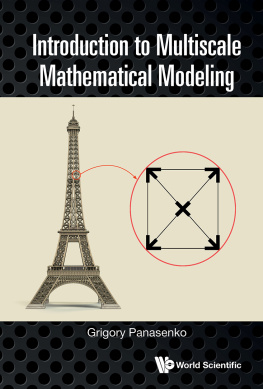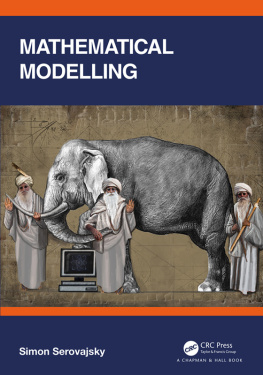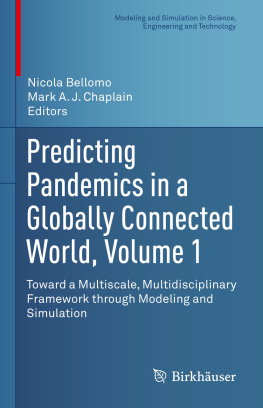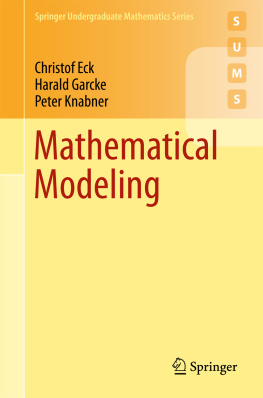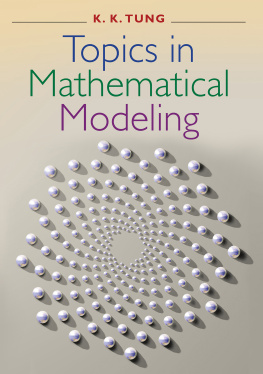Contents
Pagebreaks of the print version
 Introduction to Multiscale
Introduction to Multiscale
Mathematical ModelingIntroduction to Multiscale
Mathematical Modeling Grigory PanasenkoVilnius University, Lithuania
Grigory PanasenkoVilnius University, Lithuania Published byWorld Scientific Publishing Europe Ltd.57 Shelton Street, Covent Garden, London WC2H 9HEHead office:5 Toh Tuck Link, Singapore 596224USA office:27 Warren Street, Suite 401-402, Hackensack, NJ 07601Library of Congress Cataloging-in-Publication DataNames: Panasenko, Grigory, author.Title: Introduction to multiscale mathematical modeling / Grigory Panasenko, Vilnius University, Lithuania.Description: New Jersey : World Scientific, [2022] | Includes bibliographical references and index.Identifiers: LCCN 2022011413 | ISBN 9781800612310 (hardcover) | ISBN 9781800612327 (ebook for institutions) | ISBN 9781800612334 (ebook for individuals)Subjects: LCSH: Multiscale modeling. | Mathematical models.Classification: LCC QA401 .P28 2022 | DDC 511/.8--dc23/eng20220422LC record available at https://lccn.loc.gov/2022011413British Library Cataloguing-in-Publication DataA catalogue record for this book is available from the British Library.Copyright 2022 by World Scientific Publishing Europe Ltd.All rights reserved. This book, or parts thereof, may not be reproduced in any form or by any means, electronic or mechanical, including photocopying, recording or any information storage and retrieval system now known or to be invented, without written permission from the Publisher.For photocopying of material in this volume, please pay a copying fee through the Copyright Clearance Center, Inc., 222 Rosewood Drive, Danvers, MA 01923, USA. In this case permission to photocopy is not required from the publisher.For any available supplementary material, please visit
Published byWorld Scientific Publishing Europe Ltd.57 Shelton Street, Covent Garden, London WC2H 9HEHead office:5 Toh Tuck Link, Singapore 596224USA office:27 Warren Street, Suite 401-402, Hackensack, NJ 07601Library of Congress Cataloging-in-Publication DataNames: Panasenko, Grigory, author.Title: Introduction to multiscale mathematical modeling / Grigory Panasenko, Vilnius University, Lithuania.Description: New Jersey : World Scientific, [2022] | Includes bibliographical references and index.Identifiers: LCCN 2022011413 | ISBN 9781800612310 (hardcover) | ISBN 9781800612327 (ebook for institutions) | ISBN 9781800612334 (ebook for individuals)Subjects: LCSH: Multiscale modeling. | Mathematical models.Classification: LCC QA401 .P28 2022 | DDC 511/.8--dc23/eng20220422LC record available at https://lccn.loc.gov/2022011413British Library Cataloguing-in-Publication DataA catalogue record for this book is available from the British Library.Copyright 2022 by World Scientific Publishing Europe Ltd.All rights reserved. This book, or parts thereof, may not be reproduced in any form or by any means, electronic or mechanical, including photocopying, recording or any information storage and retrieval system now known or to be invented, without written permission from the Publisher.For photocopying of material in this volume, please pay a copying fee through the Copyright Clearance Center, Inc., 222 Rosewood Drive, Danvers, MA 01923, USA. In this case permission to photocopy is not required from the publisher.For any available supplementary material, please visit
https://www.worldscientific.com/worldscibooks/10.1142/Q0363#t=supplDesk Editors: Balamurugan Rajendran/Adam Binnie/Shi Ying KoeTypeset by Stallion PressEmail:Printed in SingaporePrefaceThis book is based on the courses given for the masters and Ph.D. students of 20152021 batch at Skoltech (Moscow), University of Chile (Santiago), University Jean Monnet (Saint-Etienne, France), University of Benevento (Italy), and Politecnico di Torino. The book introduces main mathematical models describing mechanical behavior at microscopic level of heterogeneous media and for blood flow in a network of vessels. Homogenization technique is applied for multiscale analysis of heterogeneous media. For the network of vessels, asymptotic methods (matching, boundary layers) are presented. The method of asymptotic partial decomposition of the domain defines hybrid dimension models combining one-dimensional (1-D) description obtained from the dimension reduction with three-dimensional (3-D) zooms. It justifies the special exponentially precise junction conditions at the interface of 1-D and 3-D parts. It can be applied to model the blood flow in vessels with a thrombus or a stent. The course contains an important introductory part recalling the necessary mathematical background so that it is accessible not only for the masters and Ph.D. students in mathematics but also for those in engineering and biophysics.The structure of the book is as follows. The first chapter introduces the main equations of mathematical physics. These equations are derived from the conservation laws. The main types of boundary conditions are introduced. The second chapter contains the minimal mathematical background which is required for better understanding of the multiscale methods. It recalls the main notions of analysis, . These theorems are used to prove the error estimates for the multiscale approximations.The third chapter introduces the homogenization technique as a general method used to pass from the microscopic scale to the macroscopic scale. First, this method is presented for a 1-D heat equation. Then, a similar presentation is developed in the case of the conductivity equation in multiple dimensions.Then, the error estimates are derived for the approximations of the homogenization method. These estimates are crucial to persuade the users that the method is effective and to fix the limitations of the theory. 
